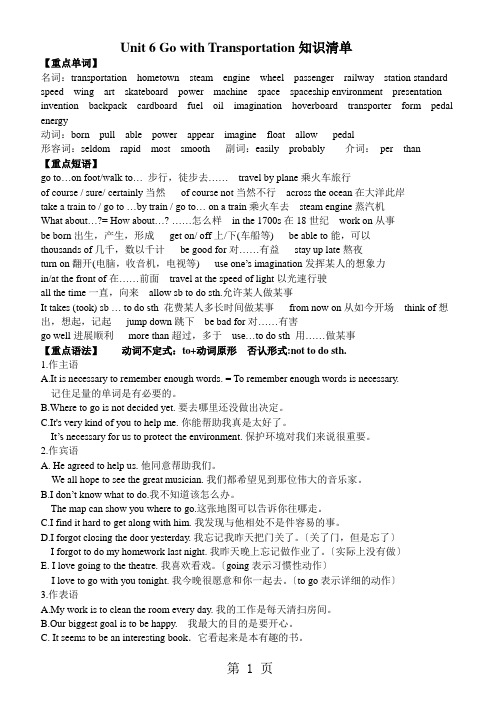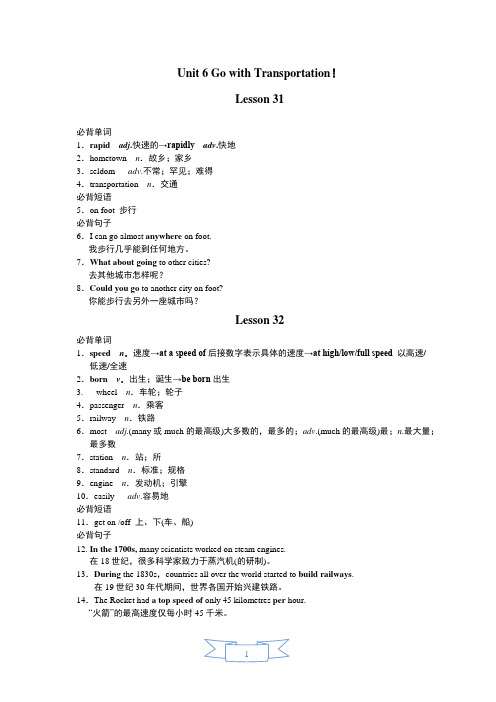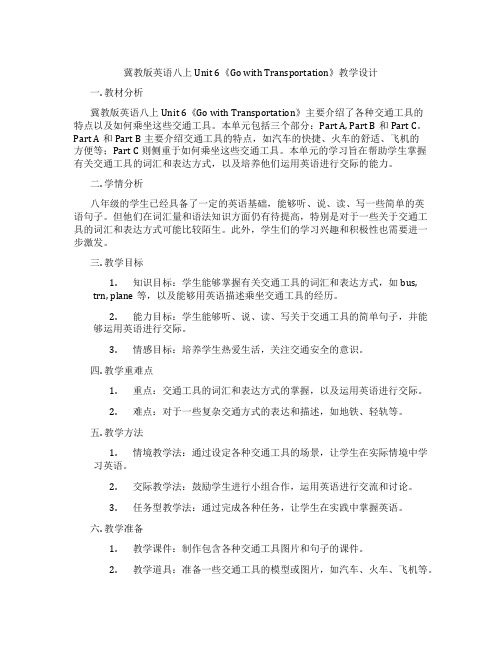【英语】冀教八年级上册Unit 6 Go with Transportation!单元知识点归纳
- 格式:doc
- 大小:47.00 KB
- 文档页数:3

Unit 6 Go with Transportation知识清单【重点单词】名词:transportation hometown steam engine wheel passenger railway station standard speed wing art skateboard power machine space spaceship environment presentation invention backpack cardboard fuel oil imagination hoverboard transporter form pedal energy动词:born pull able power appear imagine float allow pedal形容词:seldom rapid most smooth 副词:easily probably 介词:per than【重点短语】go to…on foot/walk to…步行,徒步去……travel by plane乘火车旅行of course / sure/ certainly当然of course not当然不行across the ocean在大洋此岸take a train to / go to …by train / go to… on a train乘火车去steam engine蒸汽机What about…?= How about…? ……怎么样in the 1700s在18世纪work on从事be born出生,产生,形成get on/ off上/下(车船等) be able to能,可以thousands of几千,数以千计be good for对……有益stay up late熬夜turn on翻开(电脑,收音机,电视等) use one’s imagination发挥某人的想象力in/at the front of在……前面travel at the speed of light以光速行驶all the time一直,向来allow sb to do sth.允许某人做某事It takes (took) sb … to do sth 花费某人多长时间做某事from now on从如今开场think of想出,想起,记起jump down跳下be bad for对……有害go well进展顺利more than超过,多于use…to do sth 用……做某事【重点语法】动词不定式:to+动词原形否认形式:not to do sth.1.作主语A.It is necessary to remember enough words. = To remember enough words is necessary.记住足量的单词是有必要的。

Unit 6 Go with Transportation!Lesson 31必背单词1.rapid adj.快速的→rapidly adv.快地2.hometown n.故乡;家乡3.seldom adv.不常;罕见;难得4.transportation n.交通必背短语5.on foot 步行必背句子6.I can go almost anywhere on foot.我步行几乎能到任何地方。
7.What about going to other cities?去其他城市怎样呢?8.Could you go to another city on foot?你能步行去另外一座城市吗?Lesson 32必背单词1.speed n.速度→at a speed of后接数字表示具体的速度→at high/low/full speed 以高速/ 低速/全速2.born v.出生;诞生→be born出生3. wheel n.车轮;轮子4.passenger n.乘客5.railway n.铁路6.most adj.(many或much的最高级)大多数的,最多的;adv.(much的最高级)最;n.最大量;最多数7.station n.站;所8.standard n.标准;规格9.engine n.发动机;引擎10.easily adv.容易地必背短语11.get on /off 上、下(车、船)必背句子12. In the 1700s, many scientists worked on steam engines.在18世纪,很多科学家致力于蒸汽机(的研制)。
13.During the 1830s,countries all over the world started to build railways.在19世纪30年代期间,世界各国开始兴建铁路。
14.The Rocket had a top speed of only 45 kilometres per hour.“火箭”的最高速度仅每小时45千米。

冀教版初二英语上册第6单元《GowithTransportation》知识清单【重点单词】名词:transportation hometown steam engine wheel passenger railway station standard speed wing art skateboard power machine space spaceship environment presentation invention backpack cardboard fuel oil imagination hoverboard transporter form pedal energy动词:born pull able power appear imagine float allow pedal描画词:seldom rapid most smooth 副词:easily probably 介词:per than【重点短语】go to…on foot/walk to…步行,徒步去……travel by plane乘火车游览of course / sure/ certainly当然of course not当然不行across the ocean在大洋此岸take a train to / go to …by train / go to… on a train乘火车去steam engine蒸汽机What about…?= How about…? ……怎样样in the 1700s在18世纪work on从事be born出生,发生,构成get on/ off上/下(车船等) be able to能,可以thousands of几千,数以千计be good for对……有益stay up late熬夜turn on翻开(电脑,收音机,电视等) use one’s imagination发扬某人的想象力in/at the front of在……前面travel at the speed of light以光速行驶all the time不时,向来allow sb to do sth.允许某人做某事It takes (too k) sb … to do sth 破费某人多长时间做某事from now on从如今末尾think of想出,想起,记起jump down跳下be bad for对……有害go well停顿顺利more than超越,多于use…to do sth 用……做某事【重点语法】动词不定式:to+动词原形否认方式:not to do sth.1.作主语A.It is necessary to remember enough words. = To remember enough words is necessary.记住足量的单词是有必要的。

冀教版英语八上Unit 6《Go with Transportation》教学设计一. 教材分析冀教版英语八上Unit 6《Go with Transportation》主要介绍了各种交通工具的特点以及如何乘坐这些交通工具。
本单元包括三个部分:Part A, Part B和Part C。
Part A和Part B主要介绍交通工具的特点,如汽车的快捷、火车的舒适、飞机的方便等;Part C则侧重于如何乘坐这些交通工具。
本单元的学习旨在帮助学生掌握有关交通工具的词汇和表达方式,以及培养他们运用英语进行交际的能力。
二. 学情分析八年级的学生已经具备了一定的英语基础,能够听、说、读、写一些简单的英语句子。
但他们在词汇量和语法知识方面仍有待提高,特别是对于一些关于交通工具的词汇和表达方式可能比较陌生。
此外,学生们的学习兴趣和积极性也需要进一步激发。
三. 教学目标1.知识目标:学生能够掌握有关交通工具的词汇和表达方式,如bus,trn, plane等,以及能够用英语描述乘坐交通工具的经历。
2.能力目标:学生能够听、说、读、写关于交通工具的简单句子,并能够运用英语进行交际。
3.情感目标:培养学生热爱生活,关注交通安全的意识。
四. 教学重难点1.重点:交通工具的词汇和表达方式的掌握,以及运用英语进行交际。
2.难点:对于一些复杂交通方式的表达和描述,如地铁、轻轨等。
五. 教学方法1.情境教学法:通过设定各种交通工具的场景,让学生在实际情境中学习英语。
2.交际教学法:鼓励学生进行小组合作,运用英语进行交流和讨论。
3.任务型教学法:通过完成各种任务,让学生在实践中掌握英语。
六. 教学准备1.教学课件:制作包含各种交通工具图片和句子的课件。
2.教学道具:准备一些交通工具的模型或图片,如汽车、火车、飞机等。
3.教学资源:收集一些关于交通工具的视频或音频材料。
七. 教学过程1.导入(5分钟)利用图片或视频展示各种交通工具,引导学生谈论他们所了解的交通工具。

Unit 6 Go with Transportation英语八年级上册单元知识【单元学习目标】1.语言能力:能读懂语言简单、主题相关的简短语篇,提取并归纳关键信息,理解隐含意义。
积累常用的词语搭配;了解句子的结构特征。
2. 文化意识:能通过简短语篇获取、归纳中外文化信息,认识不同文化,尊重文化的多样性和差异性,并在理解和比较的基础上作出自己的判断。
3.思维品质:能发现语篇中事件的发展和变化,辨识信息之间的相关性,把握语篇的整体意义;能辨识语篇中的衔接手段,判断句子之间、段落之间的逻辑关系。
4.学习能力:对英语学习有持续的兴趣和较为明确的学习需求与目标;有积极主动的学习态度和较强的自信心。
【单元思维导图】【单元知识梳理】一、重点单词transportation n. 交通,运输hometown n. 家乡,故乡Britain n. 英国seldom adv. 很少,罕见,难得rapid adj. 快速的,急促的steam n. 蒸汽engine n. 发动机;引擎wheel n. 轮,转向盘railway n. 铁路;铁路系统born v. 出生(bear的过去分词)passenger n. 乘客distance n. 距离;远离station n. 车站;站easily adv. 容易地;很可能的speed n. 速度,速率per prep. 每,每一standard n. 标准,水平seem v. 似乎;像是wing n. 翅膀;机翼pull v. 拉;拖;拔cart n. 二轮运货马车;手推车skateboard n. 滑板able adj. 有能力的machine n. 机器space n. 空间,场所spaceship n. 宇宙飞船cause n. 原因;理由imagine v. 想象;猜想environment n. 情况、环境等;自然环境presentation n. 显示;描述;介绍invention n. 发明;发明物backpack n. 背包fuel n. 燃料oil n. 油;石油date n. 日期probably adv. 可能,大概,或许imagination n. 想象力smooth adj. 平坦的,平稳的float v. (使)飘荡,漂浮allow v.允许;容许;准许form n. 形状;种类;形态v. 形成,产生sound n. 声音,声波pedal n. 脚蹬子;踏板than conj. 比,比较use n. 使用;用途energy n. 能量;精力二、重点短语on foot步行;徒步steam engine蒸汽机be born出生;产生;形成get on/off上、下(车、船等)be able to能;能够gets on well with 与……和睦相处turn off 关上,关掉stay up late熬夜encourage sb. to do sth. 鼓励某人做某事allow sb. to do sth. 允许某人做某事spend time/money on sth. 某人花费时间(金钱)在某物spend time/money (in) doing sth. 某人花费时间(金钱)做某事put on穿上;增加turn on打开(电/收音/电视)all the time一直;向来think about考虑prepare to do sth.准备做某事agree to do sth. 同意做某事think of想起;记起jump down跳下sound like听起来像三、重点句型1.With my invention, you don’t need an airplane to fly.2.How far will you go if you have five donuts?3.It would take a long time from Canada to Britain.4.What about going to other cities?5. In 1804, the first train engine was born in England.6.During the 1830s, countries all over the world started to build railways.7.People built many train stations to help passengers get on and off the trains easily.8.Everything seems to have wheels, engines or wings.9.In these shows, people use new forms of transportation all the time.10.A transporter would send you from one place to another very, very quickly.【单元易混易错】一、不定式不定式是一种动词的非谓语形式,没有人称和数的变化,不能单独作谓语,其构成形式为:to +动词原形,to为不定式的符号,本身无实意。

We have reviewed something about the development of transportation. So now let’s talk ab out future transportation.In the future, maybe we will have a hoverboard. It would be like a skateboard, but it wouldn’t have any wheels. It would go really fast, and the ride would be very smooth. It would float. And we may have a transporter. It would send you from one place to another very quickly. It would allow you to travel at the speed of light. Maybe cars will use water or sun energy to power them in the future. So we will have clean cars.What kind of transportation will people use in the future?I have thought of a new kind of transportation. I call it Flying umbrella. It looks like a big umbrella. With my invention, you can fly very high and far. It is very convenient. To make it work, you need to run fast at first. Then you can blow it to make it move forward. My invention is great, right? I want you to travel with it. In the passage I use many infinitives.设计意图:利用填空和给关键词的方式,复习课本重点句子,再次夯实基础。
冀教版英语八上Unit 6《Go with Transportation》(Lesson 32-33)英文教学设计一. 教材分析冀教版英语八上Unit 6《Go with Transportation》(Lesson 32-33)主要介绍了各种交通工具的英文表达以及与交通相关的词汇和短语。
本单元通过介绍不同交通工具的特点,使学生能够熟练运用英语进行有关交通的简单交流。
Lesson 32主要学习了各种交通工具的英文名称及简单的描述,Lesson 33则着重介绍了交通规则和交通标志的英文表达。
二. 学情分析学生在学习本单元之前已经掌握了基本的日常英语交流,对日常生活中常见的事物和场景有一定的了解。
但部分学生对交通相关的词汇和表达可能较为陌生,因此需要在学习过程中加强词汇的导入和操练。
此外,学生应具备一定的听、说、读、写能力,能够进行简单的英语句子构造和运用。
三. 教学目标1.知识目标:–能够听懂、会说、会读、会写各种交通工具的英文名称及描述。
–能够理解并运用交通规则和交通标志的英文表达。
2.能力目标:–能够用英语进行有关交通工具和交通规则的简单交流。
–能够运用所学的交通相关词汇和短语进行描述和表达。
3.情感目标:–培养学生对交通安全的意识,加强学生遵守交通规则的意识。
四. 教学重难点•各种交通工具的英文名称及描述。
•交通规则和交通标志的英文表达。
•交通规则和交通标志的英文表达及运用。
•能够用英语进行有关交通工具和交通规则的简单交流。
五. 教学方法1.任务型教学法:通过完成各种任务,让学生在实际运用中掌握知识。
2.情境教学法:创设各种交通场景,让学生在真实情境中学习并运用英语。
3.交际式教学法:引导学生进行生生、师生之间的互动交流,提高口语表达能力。
六. 教学准备1.教学材料:冀教版英语八上教材、多媒体课件、交通工具图片、交通规则和交通标志图片。
2.教学设备:投影仪、电脑、音响设备、黑板、粉笔。
七. 教学过程1.导入(5分钟)–利用投影仪展示各种交通工具的图片,引导学生用英语描述这些交通工具。
Unit 6 Go with Transportation-Writing本单元的话题为“交通方式”,可就“我最喜欢的交通方式”或者“……上学/工作的交通方式”进行写作。
在写作时首先点明介绍的交通方式是什么;其次陈述自己为什么喜欢这种交通方式或者某人选择某一交通方式的理由或原因;最后展望未来,预测一下这种交通方式的发展前景。
(一)单元话题短语积累1.on foot步行;徒步2.take a train乘火车3.by ship乘船 4.be bad for对……有害5.steam engine蒸汽机 6.be born出生;产生;形成7.get on上(车、船等) 8.get off下(车、船等)9.put...together装配;把……放在一起10.hundreds of数百 11. on spaceships乘宇宙飞船12.at the beginning起初 13.stay up late熬夜14.at the front of在……的前面 15.turn on打开(电脑、收音机、电视等)16. on Wednesday morning在星期三上午17. trave l at the speed of light以光速行驶18.all the time一直;向来 19.think about考虑20.think of想出;想起;记起 21.jump down跳下22.sound like听起来像 23.more than超过;多于24. take part in参加 25. be made (in)…产于……26.in the+整十年份+-s在……世纪……年代27. on one's way to+地点名词在某人去某地的路上(二)单元话题句子积累You could take a ship to your hometown! 你可以坐船去你的家乡!But with a transporter, it would take just a few seconds.但是用输送器,它将只花几秒钟。
Unit 6 Go with Transportation!Lesson 31 How Do You Travel?Learning aims:1.Learn the information about the transportation.2.Know the transportation history and what the future transportation will be like.Learning important and difficult points:1.How many types of transportation are there in the world?2.Talk about all kinds of transportation.Learning tools:audiotape, flashcards,pictures Learning steps:Step 1. Leading inAsk the students to discuss the questions: Howdo you come to school every day? Why?S1: I come to school on foot because my home is near the school.S2: I come to school by bike because I ride my bike well.S3: I come to school by bus because my home is far away from school.Step 2. Talking aboutLet the students talk about the questions:1.What do you take if you go on a trip to Beijing? Why?2.Can you describe your favourite trip to the class?Read the text quickly and check the answers.Then read the text again and repeat after it.After a while, ask some students to read the text loudly in roles.Discuss the following question:1.What are the advantages and disadvantages of the transportations?2.If you go on a trip, where would you like to go?3.How will you go there?Let the students work in groups of three of four. After a while, present their answersto the class.Step 5 . Come to“LET’S DO IT.”Ask the students to talk in the class. Then they can give their presentation in dialogues or incomposition. Encourage them to report one by one.Step 6. Homework1. Finish off the activity book.2. Review Lesson 32.Lesson 32 Trains Go Faster!Learning aims:1.Know about the train history.2.What will the future train be like?Learning important and difficult points:1. The invention of the steam engine, the first steam locomotive, railways and the first passenger.2.Who invented the inventions and when did they invent them.Learning tools:audiotape, flashcards,pictures Learning steps:Step 1. Leading inLet the students talk in groups about the question:“How do you usually travel to other cities ?”After discussing for a while, the students make a report to the class.Step 2. Let the students read the text then answer how is the text arranged.Step 3. Listen to the tapethe story in their own words.After repeating the text for several times, ask them to retellStep 4. Let the students talk more about the trainsThey may talk about their experience on trains. They also may talk about the structure ofthe trains, the use of the trains and the future of them.1.Finish off the activity book.2.Preview Lesson 33.Lesson 33 Life on WheelsLearning aims:1.Learn the history of the cars.2.Describe one type of transportation in the future.Learning important and difficult points:1.Learn about the Danny wheels.2.Imagine what types of transportation will be like from one hundred years now.Learning tools:audiotape, flashcards,pictures Learning steps:Step 1. TalkingLet the students talk about something about the planes and the cars. What do they know aboutthe planes and the cars? If they know, let them say their details.Step 2. AskingAsk the students to talk about the picture in the text. What do they think about this?Step 3. Let ’s listen to the tape and answe r the following questions:Step 4. ReadingRead the text and check the answers. Then let the students read it loudly in class. Aftera while, ask the students read the text in roles.Step 5. ActionLet students act out the dialogue. They can take a circle for Danny’s wheel.Step 6. Ask some students to make sentences with the following phrases:At that time, need to, present, you’d better not.At that time, I was a little girl.You need to wear warm clothes in cold winter.Present your invention to the class.You’d better say it again.Step 7. HomeworkWrite a letter to your friend in English.Lesson 34 Flying DonutsLearning aims:1.Stimulate students’ learning interests.2.Cultivate students’ listening by catching the useful information in the listenin g process. Learning important and difficult points:1.Encourage students’ to increase creative ability.2.Why is the invention called“flying donuts” ?audiotape, flashcards, picturesLearning steps:Let some students explain it in English, while the others guess what it is. You mustsay the transportation. Such as:A transporter is very long. It can hold many people in it. It can also take goods.What is it?Step 2. Listen to the tape and answer the following questions:1.What is Danny ’s invention made of?2.Why is it called“Flying Donuts”?3.Will Danny ’s invention really work?Step 3. ReadingRead the text and check the answers. Then listen to the tape again and read after itfor several times.Step 4. AskingAsk the students to read the text in roles. Then act the dialogue in front of the class.Step 5. PracticeMake sentences with the following language points: on the way to school, turn on, at thefront ofStep 6.Homework1.Finish off the activity book.2.Preview Lesson 35.Lesson 35 Future TransportationLearning aims:1.Review words and phrases for transportation that the students learned before.2.Encourage the students to find and restate information in personal and imaginative ways.Learning important and difficult points:1.How do you demonstrate your invention?2.Learn about the use of Modal Verbs.Learning tools:audiotape, flashcards,pictures Learning steps:Step 1. Leading inLet the students answer the questions and discuss them in pairs.Step 2. Listen to the tape and answer the following questions:1.What type of transportation would Sam like to see in the future?2.What would a hoverboard be like?3.What types of transportation are in this text?Read the text and check the answers. Then play the tape for several times. Let the students repeat after it for several times.Step 4. AskingAsk the students to have a reading content. Divide the class into several groups. Each group chooses one person every time. The one reads bes t can get a star. Let’s have a competeto see which group will have the most stars.Step 5. TalkingDivide the class into several groups. Ask them to talk the future transportation that theywould like to see. Use the words and the expressions that we learn in this unit.Step 6. Homework1.Finish off the activity book.2.Preview Lesson 36Lesson 36 Clean Cars?Learning aims:1.Learn about the words and expressions about the transportation.2.Know about the development of the transportation.Learning important and difficult points:1.Grasp the modal verbs2.Talk about the possibility and impossibility.3.Modal VerbsLearning tools:audiotape, flashcards, drawingsLearning steps:Step 1. Leading inTalk about the questions:“What we want to see in t he future? Yesterday we leave this as our project. Can you show it to the class now?”Then let the students show their drawings to the class. Ask the students to explain theirinvention in English to the class.Step 2. Listen to the tape and answer the following questions:1. What did the teacher ask us to think about?2. What is Jenny’s invention?Step 3. ReadingRead the text silently and check the answers. Let the students discuss the main idea ofthe passage in details.Step 4. ListeningListen to the tape again. Then let the students tell the main idea in their own words.Step 5. TalkingTalk about Jenny’s invention. What do you think of her idea? Can you give her any goodideas?Step 6. Homework1.Finish off the Ss workbook.2.Finish off the exercises in Unit Review.Unit ReviewLearning aims:1.Know about the history of some transporters.2.Learn about the development of the future transportation.Learning important points:1.Giving Advice/Order.2.Possibility and Impossibility.Learning difficult points: ModalVerbsLearning aids:audiotape, flashcards,pictures Learning steps:Step 1. TalkingTalk about the way of coming to school. Ask the students the questions:1.How do you come to school? Why?2.How many students in the class come to school by bike, by bus or on foot?Make a chart to show the information.By bike By bus On footNumberReasonStep 2. Talk about the main idea of this unityou do with What advantages and disadvantages do the following transporters have? What dothe disadvantages? What’s your good opinion?By plane By train By bus By carAdvantagesDisadvantagesAdviceStep 3. Think about the main ideas of this unitLet the students say it in details. Talk about what would they like to see in thefuture about the transportation?Step 4. Come to the exercisesEncourage the students to ask questions and discuss them on the blackboard.Step 5. PracticeLead the students to talk about the Modal Verbs. Make sentences with can, could, would,may and might.Step 6. Come to the“Speaking the Language”Step 7. Come to the activity bookStep 8. Do some review activities。
Unit 6 Go with Transportation!
Lesson 31
必背单词
1.rapid adj.快速的→rapidly adv.快地
2.hometown n.故乡;家乡
3.seldom adv.不常;罕见;难得
4.transportation n.交通
必背短语
5.on foot 步行
必背句子
6.I can go almost anywhere on foot.
我步行几乎能到任何地方。
7.What about going to other cities?
去其他城市怎样呢?
8.Could you go to another city on foot?
你能步行去另外一座城市吗?
Lesson 32
必背单词
1.speed n.速度→at a speed of后接数字表示具体的速度→at high/low/full speed 以高速/ 低速/全速
2.born v.出生;诞生→be born出生
3. wheel n.车轮;轮子
4.passenger n.乘客
5.railway n.铁路
6.most adj.(many或much的最高级)大多数的,最多的;adv.(much的最高级)最;n.最大量;
最多数
7.station n.站;所
8.standard n.标准;规格
9.engine n.发动机;引擎
10.easily adv.容易地
必背短语
11.get on /off 上、下(车、船)
必背句子
12. In the 1700s, many scientists worked on steam engines.
在18世纪,很多科学家致力于蒸汽机(的研制)。
13.During the 1830s,countries all over the world started to build railways.
在19世纪30年代期间,世界各国开始兴建铁路。
14.The Rocket had a top speed of only 45 kilometres per hour.
“火箭”的最高速度仅每小时45千米。
Lesson 33
必背单词
1.pull v.拉;拖→push 推(反义词)
2.able adj.能;能够→be able to
3.appear v.出现;呈现;来到→disappear v.消失
4.imagine v.想象;想到
5.environment n.环境
6.machine n.机器;机械
7. wing n.翅膀
8.space n.太空;空间;距离
9.cart n.手推车
10.power v.& n.驱动;能量
11.spaceship n.宇宙飞船
必背句子
12.This world is always moving.
这个世界总是在移动。
13.Everything seems to have wheels, engines or wings.
每样东西看起来都有轮子、发动机或者机翼。
14.Boats have been around for thousands of years.船已经存在大约几千年了。
Lesson 34
必背单词
1.invention n.发明;创造→invent v.发明→inventor n.发明家
2.oil n.油;石油
3.probably adv.大概;很可能;也许
4.presentation n.介绍;陈述
5.backpack n.背包
6.cardboard n.硬纸板
7.fuel n.燃料
8.imagination n.想象力
必背短语
9.stay up late 熬夜
10.turn on 打开
必背句子
11.He wants to give a presentation on it to the class.
他想给同学们做一下关于它的介绍。
12.Will Danny's invention really work?
丹尼的发明真的可行吗?
13.Probably not,but he had fun,and he used his imagination!
或许不能,但他很开心,而且他发挥了他的想象力!
Lesson 35
必背单词
1.smooth adj.平稳的;平坦的;光滑的→smoothly adv.顺利地;平稳地
2.allow v.允许→allow doing sth.允许做某事→allow sb. to do sth.允许某人做某事3.form n.形式;形状
4.float v.漂浮
5.transporter n.运输车;输送器
必背短语
6.all the time 一直;向来
必背句子
7.A transporter would send you from one place to another very,very quickly.
输送器会很快很快地把你从一个地方传送到另一个地方。
8.Today, it takes eleven hours to fly from Canada to China.
今天,从加拿大飞到中国花11个小时。
9.A transporter would allow you to travel at the speed of light.
输送器可以让你以光的速度来旅行。
Lesson 36
必背单词
1.pedal v.& n.踏……的踏板;骑自行车;踏板
2.energy n.能量
必背短语
3.from now on 从现在开始
4.think of 想出;想起;记起
5.jump down 跳下
6.more than 超过;多于
必背句子
7.They are very bad for our environment.
它们对我们的环境非常有害。
8.That sounds like a fun project!
那听起来像是个有趣的方案!
9.I hope your presentation goes well.
我希望你的介绍进展顺利。